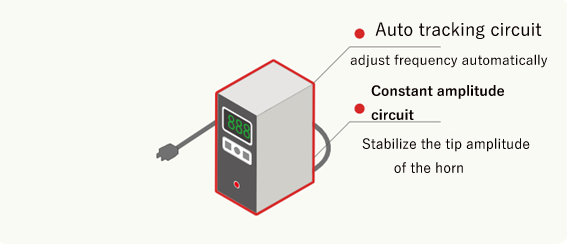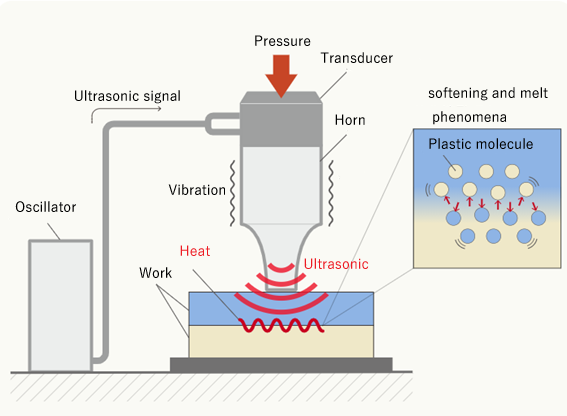Structure of an ultrasonic welding machine and the welding process

Configuration of ultrasonic welding machine
Ultrasonic welder machine for plastic (ultrasonic welder)

A typical ultrasonic welding machine consists of a device called "oscillator" that emits ultrasonic waves and an "ultrasonic welding stand".
The ultrasonic welding stand consists of a "transducer" that generates ultrasonic vibrations and a "pressurization mechanism" that moves the transducer up and down, applying pressure to the target materials.
Also, there is a stand-less ultrasonic plastic welder that consists of an oscillator, transducer and horn.
Ultrasonic oscillator

The Ultrasonic oscillator converts electrical power into ultrasound.
In addition, the oscillator of the ultrasonic welder has a "constant amplitude circuit".
Welding is repeatable due to the “constant amplitude circuit” which monitors and adjusts the amplitude of horn vibration. The amplitude is kept constant regardless of whether the work pieces are in place or how much the pressure is applied.
transducer and horn

The "transducer" for ultrasonic welding consists of a BL type Transducer to generate ultrasonic vibration, a Booster to increase the amplitude of ultrasonic vibrations and a Horn to deliver ultrasonic vibration to the work pieces.
Horn is provided in various shapes, depending on the application.
Shapes of horns
Types of horn shapes

An example of horn tips

It is no exaggeration to say that the crucial point of ultrasonic welding technology is the shape of the horn.
Horns are hand-shaped in our laboratory, to match the target work pieces.
Process of ultrasonic welding

No need to preheat, the ultrasonic welding machine is ready work as soon as the power is turned on.
「The ultrasonic wave is transmitted to the horn through the BLT.
By focusing ultrasonic energy to the tip of the horn, strong vibrations are quickly transmitted to the work pieces. The 30kHz (30,000 times per second) wave will create frictional heat at the interface of the plastic work pieces. This heat will melt the plastic to entangle their polymer chains. This type of welding can be done instantaneously.
- Contact InformationInquiries about products
- Please contact us for technical inquiries and technical information from here.